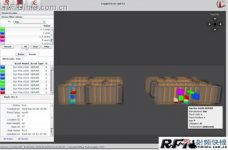
vizualiiz company implements RFID solution to locate IT equipment
[ad_1]
Several large data centers in the United States use RFID technology to monitor the center’s racks, pallets, servers and other equipment in real time, and effectively maintain IT equipment by viewing the three-dimensional map of the equipment space.
Recently, data centers of several companies in the United States have adopted RFID solutions to monitor related equipment. The RFID system deployed by Vizualiiz, called LightsOn software, uses UHF tags that comply with the EPC Gen 2 standard to monitor the server. The system can accurately locate the server, and the location can be specific to a certain shelf.

The LightsOn software developed by Vizualiiz Company presents the equipment distribution of the data center in 3D mode
Before installing the RFID system, the equipment in the data center was outsourced to other companies. Most of the equipment was managed by reading the serial number of the equipment or scanning the barcode. Usually, this process takes several weeks or even months.
LightsOn software can effectively reduce the time for inventory counting. After testing, the system can read about 1500 passive RFID tags within 15 minutes. The corresponding data processing software runs on the Linux operating system, manages the read data through a good user interface, and generates business reports. The read data is presented to the user in 3D mode, which not only shows the specific location of the device, but also makes its spatial location clear at a glance.
With the implementation of the RFID system, RFID tags are pasted on every server and related equipment in the data center. Vizualiiz did not specify the supplier of the tag, and currently uses Omni-ID UHF tags. After a series of tests, the DoTel DOTR-900 RFID reader is finally adopted. Of course, other types of UHF readers can also work normally.
The read data is forwarded to the Vizualiiz software on the backend server, or on a cloud-based server. The number of the shelf is associated with the RFID code, and the user can check the location of the server and the space display.
In addition, this solution can assist in inspection and maintenance. When the equipment reaches the maintenance period, the system will automatically remind you.
According to statistics, manual scanning of barcodes and inventory of 15,000 devices cost approximately US$56,250 a year. However, to complete the same task using the Vizualiiz RFID system only costs US$3,375 in labor costs, and greatly reduces the workload, just holding the reader close to the server. The system reduces the risk of the company’s assets being lost, allowing the company to control all the assets of the company in real time.
Carry out regular inventory checks on equipment. The handheld reader passes through the device, and the tag information read by the reader is transferred to the background data system, and the system data is updated accordingly. The system always provides the latest information of the device.
The most expensive part of the system implementation is the labeling process. In this process, the most reasonable label position needs to be tested, so that the reader can read the label information as accurately as possible.
Of course, users can also install a fixed reader and place it at the entrance to better understand the location data of the device. Especially for newly-purchased servers, if the system only uses handheld mobile readers, it is likely to be missed, which will cause discrepancies between the physical objects and the database information.
In addition, if the system changes passive to active RFID, the position data can be tracked in real time, and the reliability of the data will be higher. However, the higher cost of active tags is the key to hindering implementation. With the decline in the price of active RFID tags, active RFID solutions may be adopted in the future.
[ad_2]



